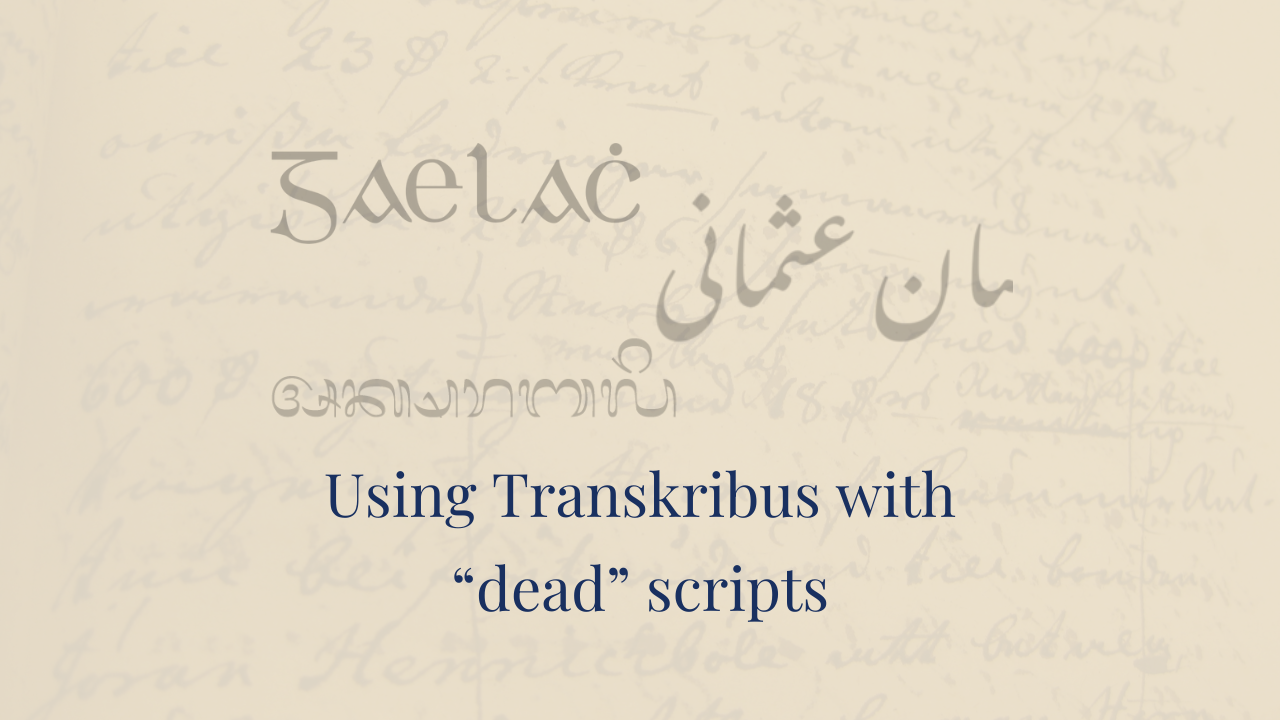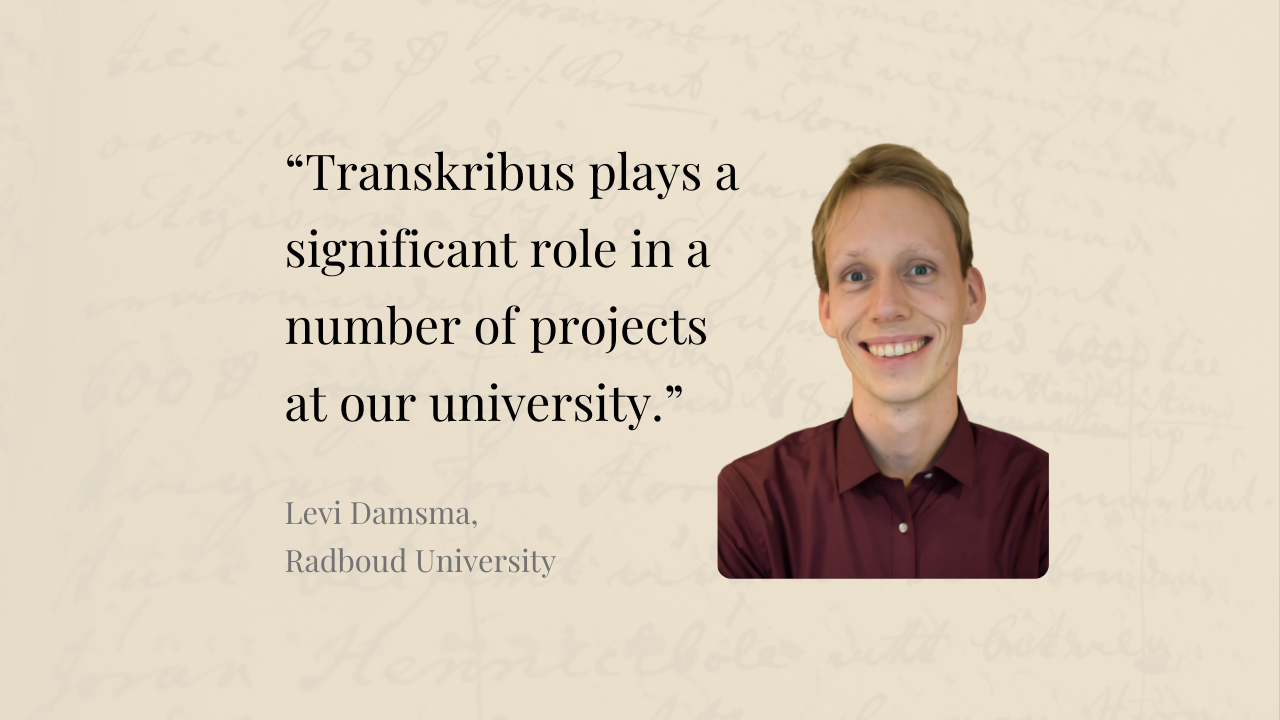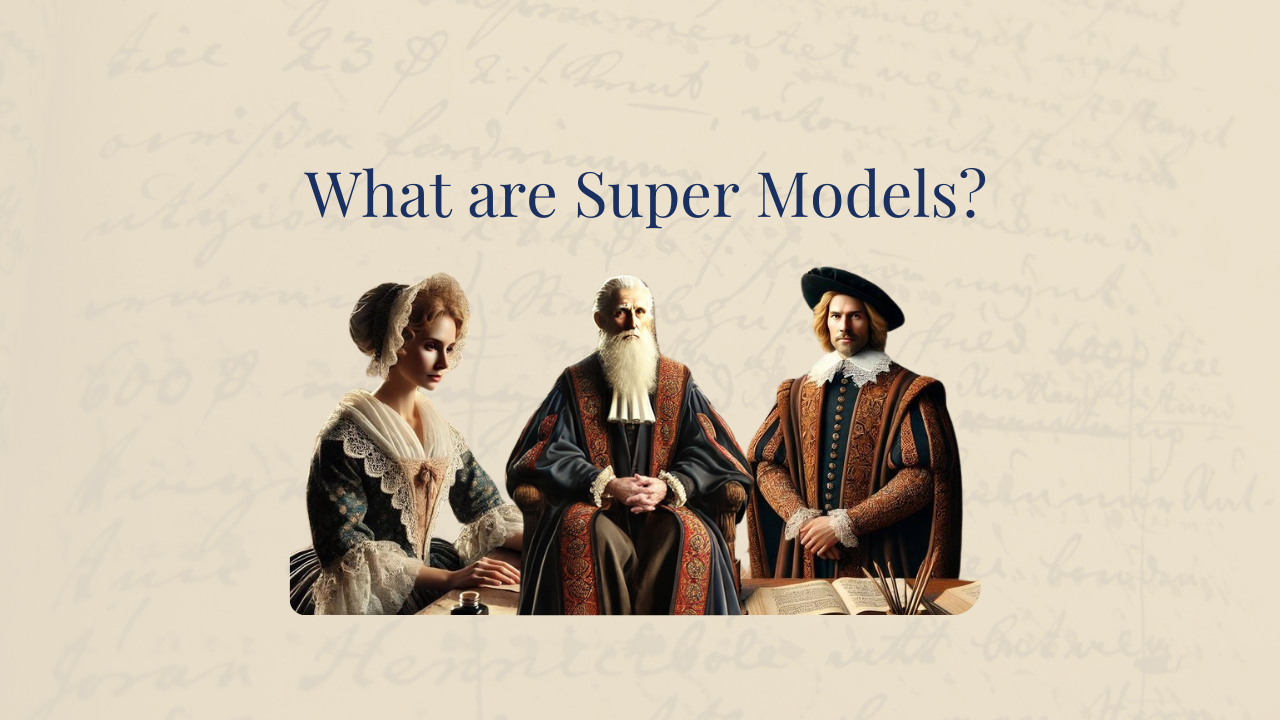
Transkribus for all: How Radboud University implemented Transkribus as an institutional service

Transkribus is used by researchers at institutions around the world. This is often done on a project-by-project basis, with scholars setting up their own accounts at the start of the project. But Radboud University in the Netherlands decided to do something different. Instead of researchers setting up individual accounts with individual credit allowances, they wanted to give their staff and students free and uncompromised access to Transkribus, in the same way that they do with journals and other digital tools.
Heading up this implementation was Levi Damsma. As a Digital Humanities Librarian at Radboud, he assists humanities researchers and students in navigating the digital landscape and has played a pivotal role in the introduction of Transkribus as a university-wide service. We talked to Levi to find out more about how the university organised this new service and learn how access to Transkribus has benefited Radboud’s staff and students.
Radboud University is based in Nijmegen, in the Netherlands. © Radboud University
A pilot project evolves into a permanent service
Radboud University's journey with Transkribus began around 2020 when a researcher at the university enquired about a subscription. "We at the library first heard of Transkribus somewhere around 2020. [A historian] at the faculty asked us at a library commission meeting whether we could offer a Transkribus subscription that the faculty staff could use," Levi recalls. Intrigued by the tool's potential, the library decided to initiate a pilot project, in which they would distribute credits free of charge to a few interested faculty members.
To do this, Levi and his team set up an Organisation plan with Transkribus, giving them a large yearly allowance of credits which they could allocate to faculty members as required. “Researchers and students can [...] request credits from us up to a certain amount, which I or my colleagues [...] then transfer to their Transkribus accounts,” Levi explains. “After a year or so, we made the pilot more accessible by offering credits to all interested staff and students in exchange for filling in an evaluation form about their experiences with Transkribus.”
This pilot project gave the team the qualitative feedback they needed to assess whether Transkribus was proving useful for research work. And generally, it seems, it was. “Many users turned out to be very positive, and Transkribus [was playing] a significant role in a number of projects at our university,” Levi said. “So after the summer of 2024, we decided to make our Transkribus subscription permanent for our staff and students.”

The library’s pilot project involved offering free credits to staff in exchange for feedback about Transkribus. © Radboud University
Providing comprehensive support and training
Of course, using Transkribus effectively for research requires a good amount of knowledge about the platform. “Using Transkribus is more than just pressing the recognition button. There’s really a lot of things to consider when designing a workflow: the desired quality, challenges in the layout, dealing with messy writing, preparing Ground Truth and training models,” Levi explained. “It’s important to be able to advise users about this, to make sure new users don’t get disappointed after trying a recognition model on their documents.”
With that in mind, Levi and his team offer comprehensive support and training to enable researchers to get the most from the platform. "I [...] give workshops every now and then. I also advise users individually – we meet at my (or their) office, take a look at the source materials, think about what Transkribus might be able to achieve with these materials, what level of accuracy they can reasonably expect, and talk about suitable workflows.”
The level of support Levi and his colleagues need to provide varies, depending on the user and the project they are working on. “Some users don’t need any support or advice and only contact me to request credits, while I cooperate quite closely with others.”
Levi supports staff and students in using Transkribus, for example, with this video. © Levi Damsma
Diverse projects and significant impact
The impact of Transkribus at Radboud University is evident in the diverse range of projects currently being undertaken by staff and students. "There’s a large variety of source materials that both staff and students are working with, ranging from early modern philosophical printed works to private letters from the Second World War," Levi explains. Some projects utilise Transkribus as a supplementary tool, for example, to search documents for specific words or passages. There are, however, some larger projects that are only made possible with Transkribus.
One such project is the Historical Database of Suriname and the Caribbean (HDSC), led by Dr. Coen van Galen. This large-scale project aims to digitise a great number of historical population records from the 19th and early 20th centuries in former Dutch colonies in the Caribbean region, enabling the public to trace their roots into this colonial slave society and scholars to study this turbulent era in history.
“As the project is first and foremost for the public, we initially invited the public to collaborate and extract names, places and dates from the records,” explained HDSC project member, Björn Quanjer. “[But] as our corpus involves hundreds of thousands of documents, we searched for a way to speed up the process.” With the help of custom layout models, the team was able to recognise and transcribe the text in the records much more quickly than would have been possible manually.
“[However], this did not mean that our citizen scientists are without a job,” Björn clarified. “As we deal with very sensitive material, just one spelling error could result in a formerly enslaved having the same name as their former owners, as these names were often quite similar. Hence, we have the public check our former output; in this way, they are still very much involved, and we make sure the number of mistakes is limited.”
You can find out more about the HDSC project on their website.
An example of one of the documents that the HDSC project is using Transkribus to digitise. © Björn Quanjer
A growing interest and positive feedback
There is an ever increasing number of digital humanities projects taking place at Radboud. "I think there has been a growing interest in DH tools at the faculty in the last few years,” Levi told us. Implementing tools such as Transkribus as a university-wide service is one reason for this shift. “By offering support and credits for Transkribus, and by supporting other DH tools as well, we at the library have made these tools more visible.”
Another reason is the fact that Transkribus is increasingly capable of transcribing documents “out of the box”, without too much optimisation by the user. “Having to prepare and train your own text recognition models is sometimes a barrier for researchers who are looking for an easy solution in their busy research schedule, especially when [automatic text recognition] is not a central focus of their project.”
“But now, Super Models can get good results that are sufficient for many research purposes. Transkribus has gotten a lot better since we started a few years ago.”
Thank you, Levi, for taking the time to talk to us. Since this post was written, Levi has changed roles and is no longer at Radboud University. We wish him all the best in his new position!
Interested in implementing Transkribus as a service at your university or institution? Contact us now to talk about setting up a tailored subscription plan.


